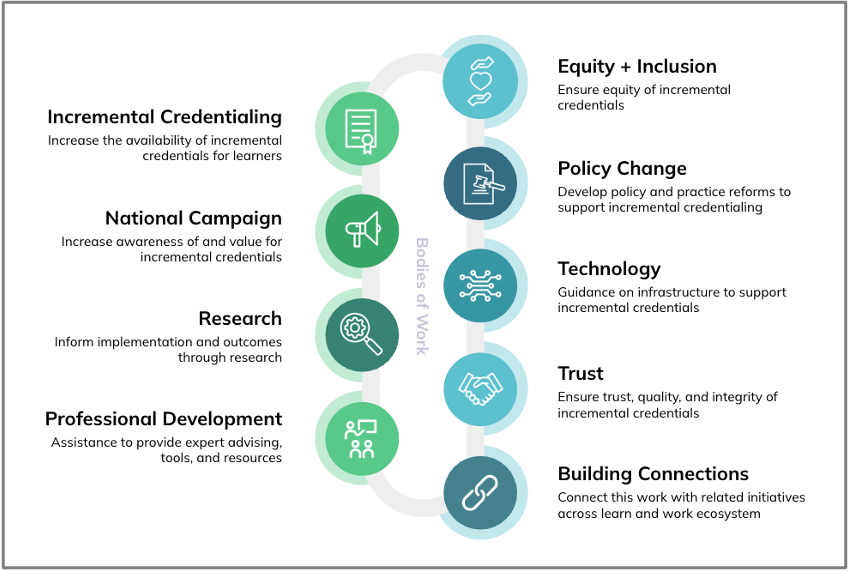Published on
What’s Beyond Mapping the Learn-and-Work Ecosystem & Key Efforts

Many organizations are working to improve the learn-and-work ecosystem—in the U.S. and in other nations. The Learn & Work Ecosystem Library has catalogued hundreds of initiatives, alliances, and networks that are doing just that. They are developing new approaches and finding innovative solutions in several areas, including: new credentialing systems, microcredentialing and badging, skills-based hiring, digital platforms to expand opportunities for learners, navigation and career advising, data standards to enable interoperability of information, and policies to guide system change.
Credential As You Go is just one of these efforts. Our initiative works to support a national movement that can transform the U.S. postsecondary system into an incremental credentialing system that is fairer for all Americans. Two questions are key to our research: Can we map what is happening in the landscape of credentialing? Can we inventory the initiatives and alliances in the three states in which we work most closely: Colorado, New York, and North Carolina?
After more than a year of study, we have two answers and another question: “Yes. Yes. But then what?” Here’s the reason for our answers and new question.
Credential As You Go’s work—trying to transform the nation’s degree-centric learn-and-work ecosystem to a “credential as you go” system that recognizes learning as it is acquired throughout an individual’s education and career journey—depends on change. And that change must occur in many components of the ecosystem. In fact, we have nine bodies of work in our workplan:

We recognized going into this work that it had to be broad-based, encompassing many areas of change. We also were aware that Credential As You Go is just one of many initiatives working to transform the system.
The work began with three states, and our approach was rooted in research and development. First, higher education institutions in those states would develop new incremental credentials. Next, we would conduct rigorous research to assess the outcomes of those initiatives and objectively inform the field whether “credentialing as you go” improves the system. We also made it a priority for our research to highlight inequities in the nation’s current system of postsecondary education—a system that has consistently been unfair for so many Americans.
One of our bodies of work has been to build connections—to link related initiatives across the learn-and-work ecosystem. This opened two lines of work:
- Identify other initiatives underway in the three states. This would allow the various efforts to leverage resources, learn from each other, and improve and accelerate the work of incremental credentialing.
- Identify and try to map key initiatives, alliances, and networks in the larger landscape. Again, the intent was to improve collaboration, leverage resources, share lessons, and improve and accelerate all of our work.
The results of this work are two new reports, each of which offers a time-limited snapshot of the dynamic field of work-related credentialing:
- Report on Policies & Initiatives Related to Credential As You Go: Colorado, New York, and North Carolina. This report provides an inventory for each of the states and shows where efforts overlap.
- Credential As You Go - Mapping Key Learn-And-Work Ecosystem Initiatives/Alliances. This provides descriptions and analyses of key national efforts that are listed in the Learn & Work Ecosystem Library.
Regardless of how crowded the landscape of innovation has become—and it is crowded, especially in states known for innovation such as Colorado, North Carolina, and New York—all of these initiatives (we identified 27 just in the three states) are helping to change the ecosystem.
The first national maps we’ve developed demonstrate how much the various initiatives and alliances have in common—including vision/scale/scope, timelines, and staffing. But the maps also show differences—especially in leadership structures and funding sources.
The real question is: What comes next? Yes, we can inventory efforts and build maps. This can inform us about the landscape of change and open doors to collaboration. But to what end? Now what?
First, since we have confirmed that technology allows us to collect and centralize information and share it in new ways (i.e., through the Learn & Work Ecosystem Library and other emerging centralized databases), we can and should build better information resources.
Second, we can ask leaders to identify the efforts underway in their states and locales, and enter them into the databases.
Third, we must take this new information and work together in ways that accelerate and strengthen all our efforts. The guiding question might be: How quickly can we transform the U.S. postsecondary system to build a fairer system for all Americans? And “we” does not mean us at Credential As You Go; it means the more than 400 initiatives, alliances, and intermediaries working in this space that we identified so far at the Learn & Work Ecosystem Library.
That is the challenge ahead. Yes, examine the new maps and inventories of initiatives and alliances in our state inventories. Then, as collaborators, develop action steps to leverage them for the greater good—as quickly as possible.

